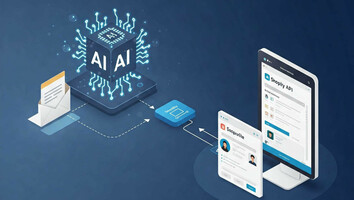With the continuous changes in technology and acceptance of new technologies, it is noticed that the technology for making payments is also changing. It started with cash payments, then progressed to debit cards and credit cards, and now to digital wallets, making quick and easy payments. Well! The latest in the world of payment technology is the Web3, also known as the decentralized web, a new technology helping people to make quick and safe online payments. This technology makes use of smart contracts to carry out transactions, built on the Ethereum blockchain. The transactions here are carried out without any third-party intermediary and this reduces the risk of fraud cases while ensuring a secured-transparent payment.
Web3 is disrupting the payment industry by eliminating third-party intermediaries and this is leading to a new payment method that is completely secured and cost-effective. The future of Ethereum-based decentralized apps supports better customer experiences, quicker payment processing times, and lower transaction costs. The possibilities of this latest technology are endless, helping to create a unique era of payments. This payment technology will be used in every industry in the future, from banking to retail.
How Web3 marks the Future of Payments?
Traditional Web2 payments take a few days to settle a payment, but blockchain payments can carry out payments quickly and safely in a few seconds to minutes. Also, the Web3 payment system supports international transfers in an easy way, eliminating complex currency conversations and costly fund transfer fees. P2P (peer-to-peer) technology is used so that no intermediary is required, which in turn reduces the costs and fees charged by the third party. It is important to mention that Web3 payment is a decentralized finance (DeFi) that uses secure ledgers for money transfer while observing banks and other financial organizations that look for fees and demand data submission in return for their services. Here, we can think of a future where the data will be essential only to provide services. In other words, a future where shopping on eCommerce platforms like Amazon can be done without sharing any credit card details. The private information of the online shoppers will be safe, and shoppers will be confident that their account details will not be viewed as Web3 data is completely secured.
Tracing the evolution of the Web from 1.0 – 3.0
Tracing the evolution of the third-generation world wide web, Web3 shows that in the 1900s-2000s, Web1.0 was used for static, read-only web pages, and later, in the 2000s-2020s, Web2.0 became information-centric while being interactive. Web 3.0 in the 2020s will be more user-centric while using decentralized, private, and secured platforms.
Best Web3 Payment System
Among the different Web3 payment systems available, some of the best options are-
PayPal- For years, PayPal has been testing and playing with the Web3 protocols and is now slowly bringing blockchain technology into its marketing strategies in order to obtain quicker and better responses, along with its own crypto token. Users can transfer cryptocurrency from their own PayPal accounts to the wallets/exchanges of others, as this was implemented in June of 2022. This is a new platform for sending cryptocurrency through PayPal services, and it is anticipated that PayPal will continue to make improvements to exchanges, just as it initially revolutionized Web2 payments.
OpenSea-It is one of the biggest Web3 platforms that supports customers to purchase and trade NFTs along with other crypto assets. The best thing about this Web3 payment platform is that transactions occur via P2P transactions between customers and sellers, rather than using a centralized system, allowing for immediate buying and selling.
Ethereum- It is a perfect decentralized and open-source blockchain platform that allows users to carry out trading, borrowing, and lending in a quick and easy way. The payments and exchanges don't require permission, are non-hierarchical, and are peer-to-peer based; making it a perfect example of the new Web 3.0 payment platform that supports the purchasing and trading of NFTs.
Why Web3 is the future of payments?
By now, we know that Web3 allows secure, transparent, and autonomous decentralized financial transactions, making it a perfect option for payments in the future. Throwing further light on the Web3 features, you must know about its-
Autonomy- It provides better autonomy and control over the financial transactions of a user and can be done directly among individuals without the use of banks/credit card companies or any other intermediate.
Genuine fees- Traditional financial transactions were costly as compared to the transactions on the blockchain, as the charges of intermediaries are removed.
Security- Blockchain supports decentralized transactions that are extremely secure because the transactions are recorded on a tamper-proof public ledger that cannot be hacked and this prevents fraud cases.
Transparency- Since all transactions are recorded on a public ledger, there is a scope for complete transparency and traceability. This further supports the system in decreasing fraud cases while building trust.
How to Make Payments on Web3?
The question that comes to your mind is how Web3 allows you to make payments while being an ideal platform for future payments. Well! The answer to this is the nature of Web3 wallets that allows the user to get engaged with the decentralized applications on the blockchain while holding digital assets with the inclusion of fungible as well as non-fungible currencies. There are 3 ways to make Web3 payments-
- Use of wallets and Web3 SDK to make payments via dApps- There are different blockchains supported by Web3 wallets like-
- Browser Extension
- Browser Wallets and
- Mobile Wallets
Valuable currencies can be kept in Web3 wallets by a user by creating an account. A set of public and private keys are available for the Web3 wallet, and coins can be transacted along with other assets using the key that serves as the user's address. For password requirements, the private key is required for every activity inside the wallet that is linked. To avoid security fraud the code must be kept a secret. The best part is that the accounts that have been created using the same private key can easily be imported by a Web3 wallet. Several versions can easily be created and controlled by the users.
- Use of Web3 wallets as Browser Extensions to make payments-While using this way, there is a need to obtain and turn on the browser add-on. An existing account can be imported via a private key, and the wallet password can be configured prior to setting up a new account. A seed phrase is provided which should be kept secured for restoring the account and recovering funds.
- To make transactions you can connect to the Web3 wallet browser extension via JavaScript dApp- The dApp requires linking to the wallet extension while using the window object for different blockchains. The window object is capable of recording and displaying objects for different Web3 wallet extensions that are active in the browser. The use of the web3.js library is good to communicate with blockchains and wallets. Window objects might have a similarity with the previous object for other web3 wallets and the current provider key has the information about the account from the current wallet. The best method can be chosen to make a Web3 payment, according to the need.
Let’s Sum Up!
The efficient nature of Web3 payment infrastructure allows a person to access goods and services across the globe with the aid of an internet connection. This marks the future of Web3 for quick and safe payments. The connectivity and mobility between different platforms and applications are excellent, further accelerating Web3 development in the near future.



